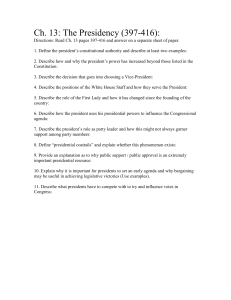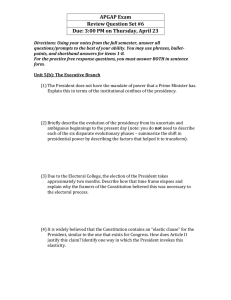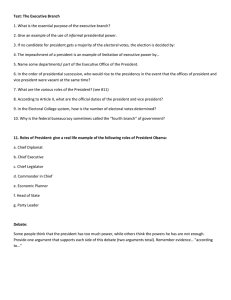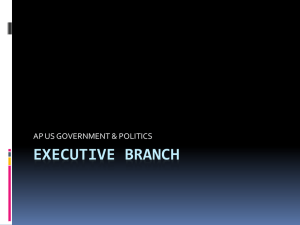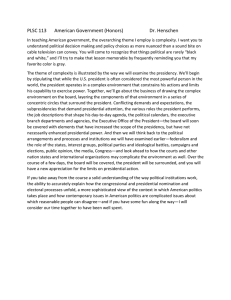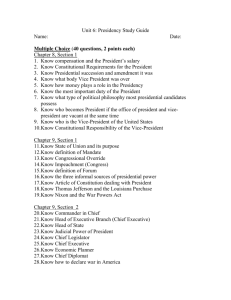The Executive Branch Review
advertisement
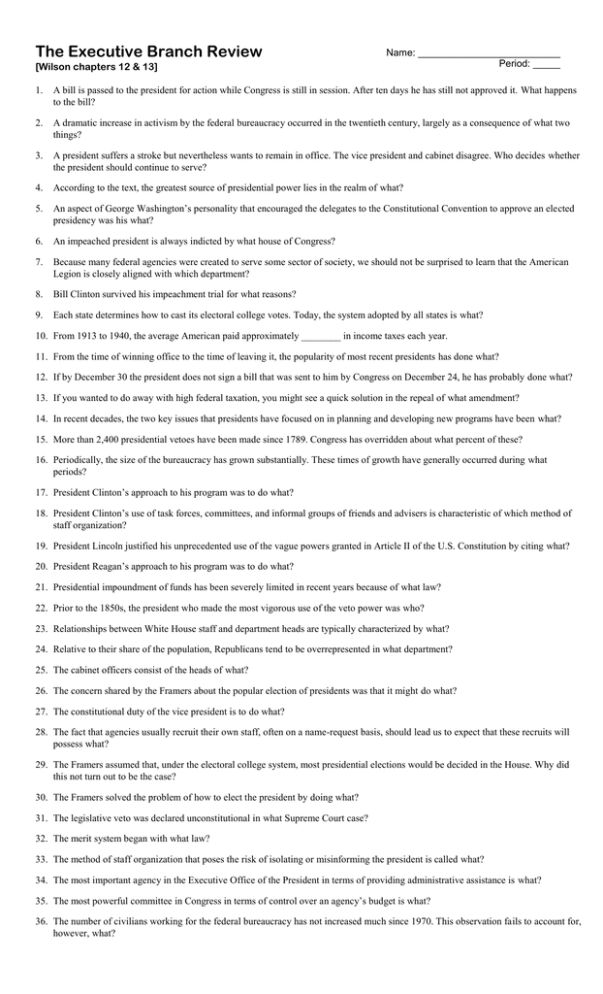
The Executive Branch Review [Wilson chapters 12 & 13] Name: __________________________ Period: _____ 1. A bill is passed to the president for action while Congress is still in session. After ten days he has still not approved it. What happens to the bill? 2. A dramatic increase in activism by the federal bureaucracy occurred in the twentieth century, largely as a consequence of what two things? 3. A president suffers a stroke but nevertheless wants to remain in office. The vice president and cabinet disagree. Who decides whether the president should continue to serve? 4. According to the text, the greatest source of presidential power lies in the realm of what? 5. An aspect of George Washington’s personality that encouraged the delegates to the Constitutional Convention to approve an elected presidency was his what? 6. An impeached president is always indicted by what house of Congress? 7. Because many federal agencies were created to serve some sector of society, we should not be surprised to learn that the American Legion is closely aligned with which department? 8. Bill Clinton survived his impeachment trial for what reasons? 9. Each state determines how to cast its electoral college votes. Today, the system adopted by all states is what? 10. From 1913 to 1940, the average American paid approximately ________ in income taxes each year. 11. From the time of winning office to the time of leaving it, the popularity of most recent presidents has done what? 12. If by December 30 the president does not sign a bill that was sent to him by Congress on December 24, he has probably done what? 13. If you wanted to do away with high federal taxation, you might see a quick solution in the repeal of what amendment? 14. In recent decades, the two key issues that presidents have focused on in planning and developing new programs have been what? 15. More than 2,400 presidential vetoes have been made since 1789. Congress has overridden about what percent of these? 16. Periodically, the size of the bureaucracy has grown substantially. These times of growth have generally occurred during what periods? 17. President Clinton’s approach to his program was to do what? 18. President Clinton’s use of task forces, committees, and informal groups of friends and advisers is characteristic of which method of staff organization? 19. President Lincoln justified his unprecedented use of the vague powers granted in Article II of the U.S. Constitution by citing what? 20. President Reagan’s approach to his program was to do what? 21. Presidential impoundment of funds has been severely limited in recent years because of what law? 22. Prior to the 1850s, the president who made the most vigorous use of the veto power was who? 23. Relationships between White House staff and department heads are typically characterized by what? 24. Relative to their share of the population, Republicans tend to be overrepresented in what department? 25. The cabinet officers consist of the heads of what? 26. The concern shared by the Framers about the popular election of presidents was that it might do what? 27. The constitutional duty of the vice president is to do what? 28. The fact that agencies usually recruit their own staff, often on a name-request basis, should lead us to expect that these recruits will possess what? 29. The Framers assumed that, under the electoral college system, most presidential elections would be decided in the House. Why did this not turn out to be the case? 30. The Framers solved the problem of how to elect the president by doing what? 31. The legislative veto was declared unconstitutional in what Supreme Court case? 32. The merit system began with what law? 33. The method of staff organization that poses the risk of isolating or misinforming the president is called what? 34. The most important agency in the Executive Office of the President in terms of providing administrative assistance is what? 35. The most powerful committee in Congress in terms of control over an agency’s budget is what? 36. The number of civilians working for the federal bureaucracy has not increased much since 1970. This observation fails to account for, however, what? 37. The number of electoral votes a state is allotted is determined by what? 38. The position of acting president was created what? 39. The powers that the president shares with the Senate include what? 40. The presidential character of Bill Clinton was characterized by what? 41. The presidential character of Jimmy Carter was characterized by what? 42. The presidential character of Richard Nixon was characterized by what? 43. The presidential character of Ronald Reagan was characterized by what? 44. The Senate is required to confirm all of the following presidential nominations except what? 45. The shift in the role of the federal bureaucracy that occurred between 1861 and 1901 was from what to what? 46. The text cites Jimmy Carter’s strategic arms limitation treaty and Bill Clinton’s policy on gays to illustrate what? 47. Those federal bureaucrats not appointed on the basis of qualifications designed by the Office of Personnel Management (OPM) are called what? 48. Upon the death or incapacitation of a president and the succession of the vice president, a new vice president is chosen by whom? 49. What are issue networks? 50. What are the “pathologies” commonly attributed to bureaucracies? 51. What are the constraints on government agencies? 52. What attitudes do most Americans have toward government bureaucrats and bureaucracies? 53. What did the Supreme Court decide in United States v. Nixon? 54. What executive department group is closest in physical and political proximity to the president? 55. What happens if no presidential candidate wins a majority of electoral college votes? 56. What is one major constraint on a president’s ability to plan and develop a program? 57. What is the plan to reform the bureaucracy popularly called the plan to “reinvent government” called? 58. What is true of the legislative veto in the national government? 59. What powers does Congress have regarding executive agencies? 60. What things did the delegates to the Constitutional Convention fear? 61. What were the fears expressed by the Founders about aspects of the presidency? 62. When a person is selected by the president to head an agency and to shift its policies in the direction of the president’s, the appointee generally finds that what limits his power? 63. When a presidential election is thrown into the House, one vote is cast by each what? 64. When an agency such as the Environmental Protection Agency (EPA) makes an important decision, it is quite likely to be taken to court. This is an example of what is meant by what term? 65. When congressional committees require that agency decisions be submitted to them before the agency implements them, the committees are exercising the power of what? 66. When President Reagan was governor of California, he could veto portions of a bill that were irrelevant to the subject of the bill. He was exercising what is called what? 67. When President Reagan was under anesthesia while being operated on in 1985, the relationship between him and Vice President Bush was governed by what? 68. When voters choose as members of Congress people of the same party as an incoming president, they probably do so for what reason? 69. Whereas European countries tend to control key industries by government ownership, the United States relies primarily on what? 70. Which law established the Office of Special Counsel? 71. Which of the following statements about the vice-presidential route to the presidency is correct? 72. Who succeeds to the presidency if both the president and vice president die? 73. Why are iron triangles less common today than they once were? 74. With substantial Democratic majorities in both houses of Congress, President Kennedy, during the last year of his presidency, was able to secure passage of ________ of his proposals.
